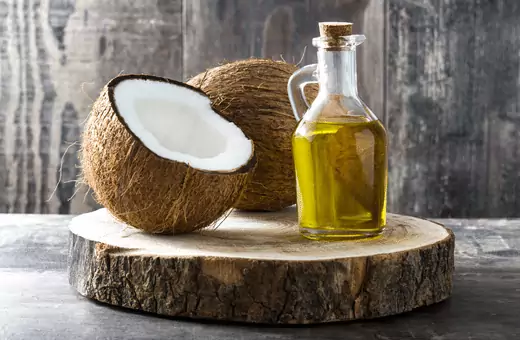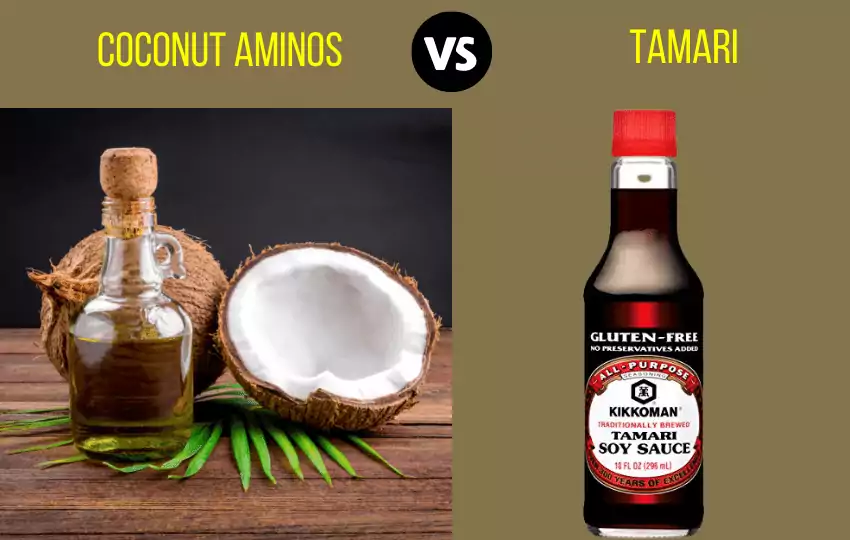You’ve certainly heard about Tamari and coconut aminos while seeking a soy-free, gluten-free soy sauce substitute, whether you’re a seasoned cook or just beginning out in the kitchen.
But what are they, and which is better for you? While they have a similar appearance, Tamari and coconut aminos have unique flavors that set them apart from each other.
In this post, we’ll break down the contrasts between coconut aminos vs Tamari, so you can decide which is best for your needs.
Let’s take a deeper look at all of them to discover which one is right for you.
If you’re in a hurry, just go through the below table best for you, and you will get an idea of these two condiment differences. Otherwise, continue to more depth comparisons.
A Quick Comparison Table: Coconut Aminos VS Tamari
| Parameters | Coconut Aminos | Tamari |
|---|---|---|
| Origin | Unknown | Japan |
| Source | Fermented Coconut Sap | Fermented Soy sauce |
| Taste | Sweet but a cross between soy sauce & Teriyaki | Sweet- Salty Soy sauce-like taste |
| Texture | Darker and thick | Darker but thin |
| Soybean Present | No | 100% |
| Storage | Dry place | Dry place |
| Shelflife | last for up to two years | last for up to 1 year |
| Uses | Marinate, salad dressing & Soy-free alternative to soy sauce | Marinate, Salad dressing, Glazing, A gluten-free alternative to soy sauce |
| Healthy | Healthier than Tamari | Less Healthy Than Coconut Aminos |
| Gluten Present | No | No |
| Vegan | Yes | Yes |
What is Tamari?
Tamari sauce is a soy sauce that originates from Japan. Tamari is also known as Japanese shoyu. It is made with fermented soybeans without wheat. It is typically darker, thicker in consistency, and richer in flavor than regular soy sauce.
Tamari sauce is commonly used as a dipping sauce or as a seasoning for various Japanese dishes or is often used in dishes where a stronger soy flavor is desired. Tamari is gluten-free and vegan.
What Is Coconut Aminos?
Coconut aminos are a savory, slightly sweet sauce made from fermented coconut sap and sea salt. They have a comparable taste and consistency to soy sauce, making them a great soy-free alternative for stir-fries, marinades, and more.
Coconut aminos are a good source of amino acids, the building blocks of protein.
It is also a good source of potassium and magnesium. Coconut aminos are gluten-free, dairy-free, and vegan.
Taste and Texture: Tamari VS Coconut Aminos
Coconut aminos is a slightly sweet, savory sauce made from coconut sap and sea salt. It is less salty and has a sweeter flavor than soy sauce.
Many say it tastes like a cross between soy sauce and teriyaki sauce. But it does not taste like coconut.
Tamari is made from 100 percent soybeans, which gives it a mellower flavor than traditional soy sauce.
In addition, Tamari is less salty and has a more nuanced flavor than its counterparts. As a result, it is an excellent choice for those looking for a less salty soy sauce option.
Tamari has a dark brown color and a rich, salty flavor. At the same time, coconut aminos are darker in color and have a sweeter, umami flavor. Tamari is also lighter in consistency than coconut aminos.
How to Use: Coconut Aminos VS Tamari Sauce
When used as a condiment, Tamari can be added to rice dishes, soups, and sauces to give them an extra boost of flavor.
Coconut aminos can be used in the same way but are also often used as a marinade or dipping sauce.
Otherwise- The best way to use Tamari
-Use it as a marinade for meats or vegetables before grilling or stir-frying.
-Add it to soup or stew for extra flavor.
-Drizzle it over cooked rice or noodles.
-Use it as a dipping sauce for dumplings or spring rolls.
-Mix it with other sauces or seasonings to create your own unique flavor.
-You can also use it as a dipping sauce for sushi or dumplings. If you are looking for a gluten-free soy sauce alternative, tamari sauce is a great option.
The best way to use Coconut aminos in your cooking
You can use it as a marinade for meats or fish, add it to stir-fries or curries, or simply use it as a dipping sauce.
Coconut aminos also make a great addition to salad dressings. They can be used in place of soy sauce in any dish.

Making Process: Coconut Aminos and Tamari
In case you need any of them, use these recipes to make them.
How to Make coconut aminos
1. Combine 1 cup of water with 1 cup of coconut sugar in a saucepan over medium heat.
2. Mix until the sugar dissolves and get the mixture to a boil.
3. Reduce the heat to low and add 1 cup of coconut sap or nectar. Simmer for about 10 minutes.
4. Remove from heat and cool slightly. Put in a glass jar or bottle and refrigerate for up to 2 months.
5. To use, simply add Coconut Aminos to your favorite recipes in place of soy sauce or Tamari.
How to make tamari sauce at home?
Tamari sauce is a soy sauce that is made with wheat. To make tamari sauce home, you will need soy sauce, rice vinegar, and honey.
First, combine the soy sauce, rice vinegar, and honey in a bowl and stir to combine. Then, pour the blend into a pot or bottle and store it in the fridge. Tamari sauce will keep for up to six months in the fridge.
Compare Tamari sauce Vs Coconut aminos by their storage:
Tamari can be stored in a cool, dry place for up to a year. Once opened, Tamari will last for 6-8 months if stored in the fridge.
Coconut Aminos can be stored in the fridge or at room temperature. They should be stored in an airtight container to keep them fresh.
Coconut aminos can be stored in a cool, dry place like a pantry or cupboard. Coconut aminos will last for up to two years when stored properly.
Read More- Ideal Tamari sauce substitutes
How long Does it Last: Tamari sauce VS Coconut Aminos
Coconut aminos have a shelf life of about two years. However, after opening the bottle, it is recommended to consume it within six months.
Tamari will last for 2 years if it is stored properly. If stored in an unopened container in a cool, dark place. Once opened, Tamari should be refrigerated and used within 6 months.
Even though Tamari has a long shelf life, the flavor will start to deteriorate after 2 years. So, it’s best to use it within 6 months of opening.
Is coconut aminos healthier than Tamari?
There are multiple factors to think about when it comes to one’s health. However, some experts believe coconut aminos may be healthier than Tamari because they contain less sodium and lower calories.
Additionally, coconut aminos are said to be a good source of Vitamins B and C, while Tamari is not.
Coconut aminos are less processed than Tamari and have a sweeter flavor, which some people prefer.
Ultimately, the best way to determine if coconut aminos or Tamari is the better choice for you is to test with both and see which you like.
Read More- Mirin VS Rice Vinegar
Bottom Line: Are coconut aminos and Tamari the same?
Coconut aminos and Tamari taste and look similar, but they differ in several ways.
Tamari is made with whole fermented soybeans, while coconut aminos are made with fermented coconuts. This gives each sauce a distinct flavor: Tamari is more savory, and coconut aminos are more sweet umami and fragrant.
Additionally, tamari and coconut aminos both do not contain gluten. As a result, those with gluten sensitivities or celiac disease may prefer to use any of them.
Coconut aminos have a lower sodium content than Tamari. Both sauces can be used interchangeably in most recipes, but you may want to experiment to see which one you prefer.
FAQs
Q1. Can I use tamari sauce instead of coconut aminos?
Yes, you can use tamari sauce instead of coconut aminos.
Tamari sauce is a soy sauce made without wheat, so it is gluten-free. It has a flavor similar to soy sauce but is less salty.
Coconut aminos is a sauce produced from the amino acids in coconuts. It has a slightly sweet taste and is lower in sodium than soy sauce.
q2. How do you cook with coconut aminos?
Coconut aminos can be used in various ways in the kitchen. They make an excellent replacement for soy sauce in stir fry dishes, marinades, and as a dipping sauce.
You can also utilize them to add flavor to soups, stews, and curries. Simply substitute coconut aminos for soy sauce in any recipe. For best results, start with a lower amount of coconut aminos and then adjust to taste.

